
Mazda CX-5 Review

Introduction
The CX-5 sits in the tough and competitive family-sized SUV market – so it needs to make sure it’s got the looks and the practicality to compete with its rivals.
It is so far, so good for Mazda. Despite the pandemic, the automaker sold over 360,000 CX-5s in 2020, which accounted for almost 30% of all Mazdas sold worldwide. So it stands to reason that the firm is doing something right.
Select's rating score* - 3.9 / 5
At a Glance
The attraction is not difficult to see. The car has a large, indented grille with chrome surrounds that sweep upwards, linking to the headlights, which look squinted. This design creates a frowning appearance, giving off a vibe of sportiness and aggression.
There is also a modest sloping roofline toward the back, meeting an unintrusive spoiler that overhangs the rear windscreen.
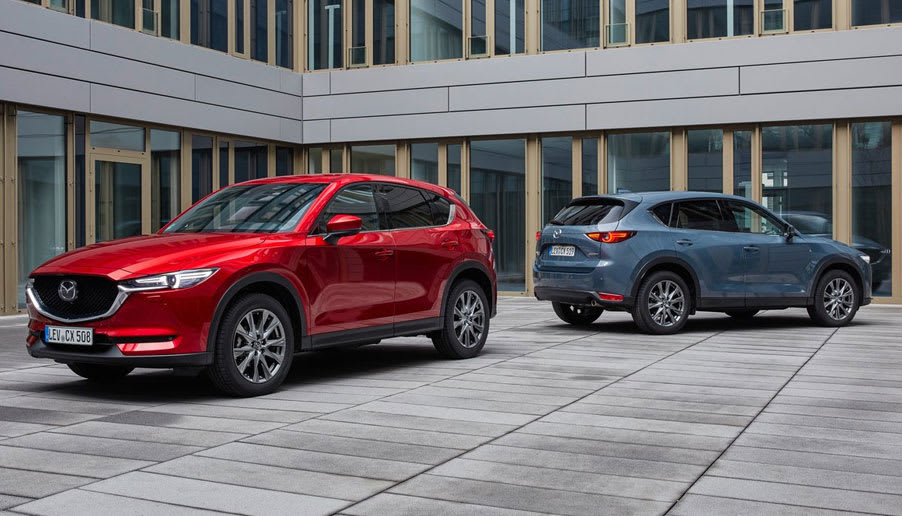
The rear lights curve around from the sides and taper in, pointing towards the Mazda badge in the middle, while there's a sizeable grille-shaped indentation in the bodywork surrounding the number plate.
The SUV looks attractive to us, although we think there’ll be some folk out there who find the design a little bit fiddly, especially at the back.
Nevertheless, Mazda has done an excellent job – it’s certainly more imaginative than the Skoda Kodiaq, which looks like any other Skoda, just that it’s put on quite a few extra pounds during lockdown.
Key Features
There are four trim levels to choose (Mazda, curiously, calls them 'grades').
First up is SE-L, which gets you 17-inch grey alloys, premium black cloth trim, a DAB radio, cruise control and six-way manually-adjustable front seats with lumbar support. SatNav (along with a five-year subscription for map updates) is included, too, as is a 10.25-inch screen, Apple CarPlay/Android Auto and front and rear parking sensors. The car also comes with pre-crash safety and brake support.
Kuro Edition is next up, adding 19-inch black alloys, half synthetic leather and half suede trim with heated front seats, black-coloured mirror caps, six-way electrically-adjustable seats in the front and a powered boot lid.
Sport trim adds 19-inch silver alloys, black leather trim, and a 10-speaker Bose surround sound system. You also get an eight-way electrically-adjustable driver’s seat, a reversing camera, keyless entry, a head-up display, traffic sign recognition and a de-icer for the front windscreen wipers.
The top-of-the-range GT Sport adds in 19-inch ‘bright’ alloys, brown Nappa leather trim, ventilated front seats and heated rear outer seats, black roof lining with wood trim detailing on the dashboard and door, Driver Attention Alert, adaptive LED headlights, an auto-dimming rear-view mirror, 360-degree cameras and an electric sunroof.
Mazda now offers four engine variants from its SkyActiv range.
There is the petrol-powered SkyActiv-G – a 2.0-litre engine putting out 165PS, alongside a new 2.5-litre four-cylinder engine producing 194PS.
The diesel-powered SkyActiv-D is available as a 2.2-litre engine, producing 150PS or 184PS.
All come with a six-speed gearbox, available as a manual or automatic, apart from the top-of-the-range petrol unit, which is only available with automatic transmission.
The lower-powered 165PS petrol engine is available in all trims.
Entry-level SE-L trim limits you to the lower-powered petrol and diesel, while the Kuro Edition is only available with the lesser-powered petrol.
All engines, apart from the top-of-the-range petrol, are available with Sport trim, while GT Sport gives you a choice of the higher-powered petrol or diesel.
Disappointingly, most models are front-wheel drive only, although you can choose four-wheel drive on the Sport with the 184PS diesel and an automatic gearbox. You can also have the same on the GT Sport, also available with a manual, or you can have the 2.5-litre petrol as an automatic only.
You also get the interestingly named i-ELOOP which is an energy recovery system connected to the brakes. Under braking, the heat generated is converted and used to power the electrical systems, saving fuel.
There are more savings to be had thanks to the vehicle's weight, too, which is nearly 100-kilograms lighter than the old CX-5.
Performance & Drive
The diesels have always had the edge over the petrols in the CX-5.
The lower-powered petrol engine has always struggled a bit, whereas the diesels pack plenty of punch, even at lower revs. Part of the reason for this is that there are no turbos on the petrol engines – and that means you need a lot more clout from the engine to do what the diesels can do.
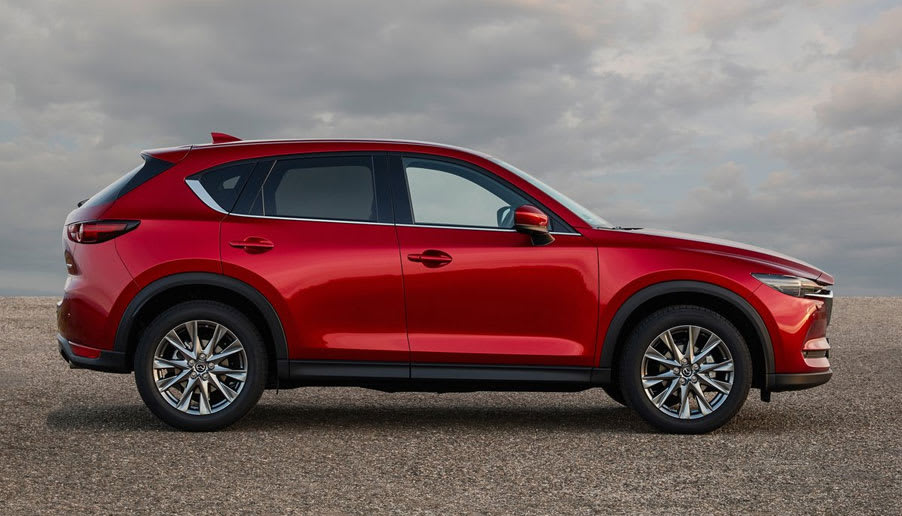
Sadly, that’s very much still the case with the 165PS petrol unit. It seems unable to provide good acceleration due to the car's weight, especially if you've got a full tank of fuel and several passengers on board.
This means higher revs are needed to maximise performance, which negatively impacts fuel consumption as you'll need to change gear later.
It is no wonder, then, that Mazda has added the 2.5-litre 194PS engine to the range. It is much keener to deliver its power at lower revs, with throttle response significantly improved, and it sounds good. It also features cylinder deactivation, meaning it will switch to two-cylinder mode when four aren’t required, saving fuel.
However, the fuel economy figures still aren’t great and, in terms of performance, it’s still only half a second quicker at 0-62mph than the 2.0-litre petrol, at 9.2-seconds (versus 9.8-seconds). The fact you can only have it with the top-of-the-range GT Sport effectively makes it an expensive and pointless exercise. The diesels are workhorses by comparison and provide more consistent performance – certainly over the smaller 2.0-litre petrol engine – with fuel economy to match.
The 184PS diesel engine is now available with front-wheel drive, too. But, while it’s good, like the petrol, it doesn’t offer such an enormous advantage over the lower-powered diesel to justify the added cost.
Both the manuals and automatics are decent, though, on balance, the automatic is our preference, changing smoothly at all speeds without jerking the car around, as some auto-boxes tend to do.
In terms of the driving experience, the CX-5's steering is precise without being on the heavy side. As a result, it is one of the more enjoyable large SUVs to drive, handling very well and performing favourably in the corners for a vehicle of its size.
The Mazda has a system called G-Vectoring which, as you go round a bend, combines with more than two dozen sensors to measure terrain and weather conditions, automatically adjusting the torque sent to the front wheels to maximise grip. So, we’ll say it again - we are very impressed with the way such a big car goes around corners.
The downside is that the excellent handling comes at the expense of comfort. The suspension is quite firm, so you feel lumps and bumps, which can be a bit unforgiving on poor road surfaces, while the Mazda never feels particularly well settled at higher speeds.
The large 19-inch alloys are partly to blame here, and the 17-inch wheels offered on the entry-level trim do improve the ride comfort somewhat, albeit making the handling slightly less responsive.
Running Costs & Emissions
The 2.0-litre 165PS petrol claims it will do 42mpg with a manual gearbox, producing 153g/km of CO2, although this decreases to 39mpg with an automatic, bumping up the CO2 figure to 166g/km.
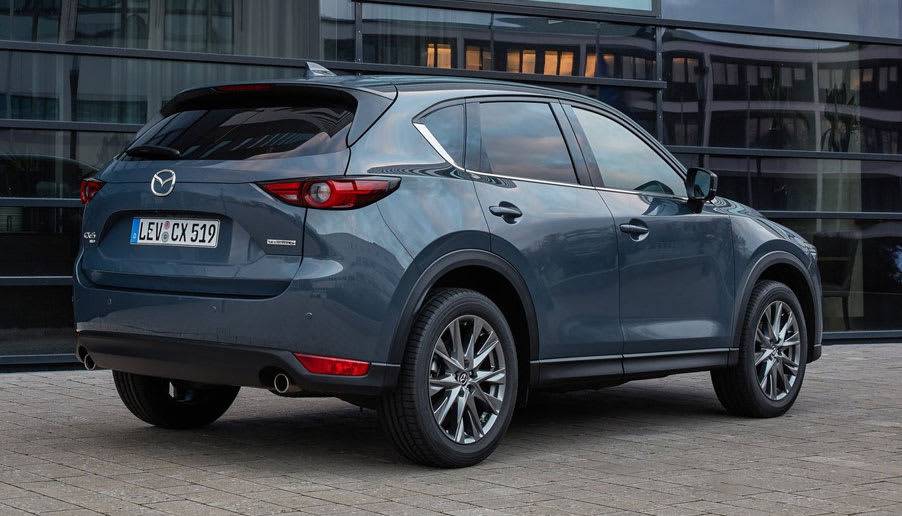
This declines further to 35mpg in the top-of-the-range 2.5-litre 194PS petrol, which is an automatic – although it has four-wheel drive, too, which is also partly responsible for the drop in fuel consumption. It produces 182g/km of CO2.
The 2.2-litre 150PS and 184PS diesels claim identical figures with a manual of 50mpg and a CO2 figure of 147g/km, or 46mpg and 160g/km of CO2 with an automatic. Add four-wheel drive in, and it claims 45mpg and 165g/km of CO2 with a manual, or 43mpg and 173g/km of CO2 with the automatic.
You only get a three-year, 60,000-mile warranty with Mazda. Still, it is extendable for an extra fee, and, of course, it is a Mazda – a manufacturer famed for its reliability – so the chances of you needing to make use of the warranty are pretty slim.
Interior & Technology
The cabin is a satisfying place to be – it looks great and feels well built, albeit not overly luxurious – and the seats are very comfortable.
There are plenty of soft-to-the-touch surfaces and lots of space, with the driver taking a high, commanding driving position.
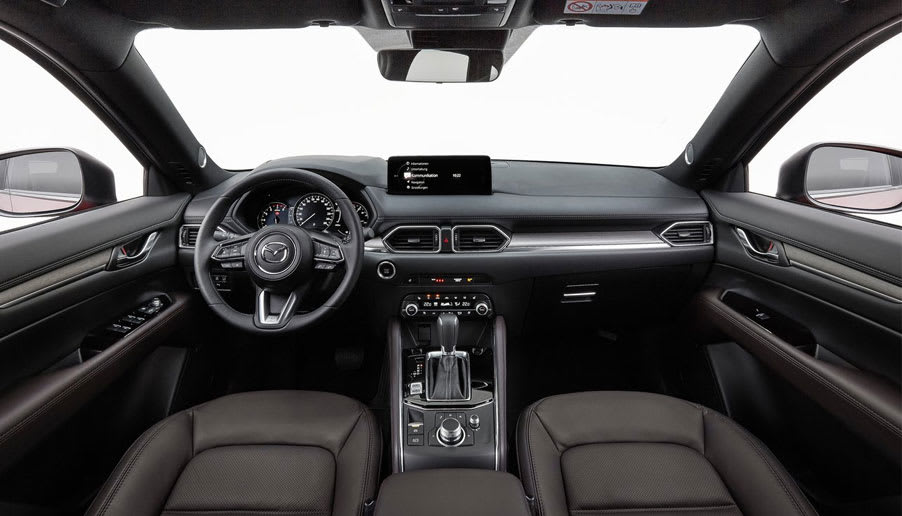
Storage space inside is plentiful, too. The door bins are big; there are two cup holders, a fair amount of storage in the centre console and a larger-than-normal space behind the gear lever to put your smartphone. Even the glove box is a respectable size.
The infotainment screen is bigger than it used to be, too. The old CX-5s only had a seven-inch screen that was just too small by today's standards, so it's good to see Mazda has added a larger one throughout the range. The manufacturer also listened to feedback about the system itself. Although it was intuitive and easy to use, its design was dated, and the resolution on the cameras was inferior before. The whole lot is now improved, so a big thumbs up is due to Mazda for taking the criticism on board.
The infotainment system on the old CX-5 had a touchscreen, but it only worked while the vehicle was stationary. The new one has completely done away with the touchscreen, using the 'multi-function commander control' on the centre console, where there are also some shortcut buttons.
On the dashboard, you get a partly digital instrumental display, but it has been updated. There are still two analogue dials, but, whereas before, you only got a digital one on the right, it's now been moved into the centre and is full of helpful information.
Practicality & Boot Space
With leg and headroom being plentiful in the front, it’s a similar story in the back.
The rear door openings aren’t the biggest. As a result, the doors open to a vast angle at the back so you can still get in and out with ease. You might be worried about needing some extra space while parking as a result, but because the doors themselves aren’t wide, this shouldn’t be a massive problem - unless you’re parked next to a monster truck.
Despite the size of the car, fitting three adults in the back might be a bit more of a squeeze than you’d hoped. It is not bad, but other rivals do have more space. The SUV is just a five-seater, too.
Our only minor gripe in the back is that the rear windows don’t go all the way down, probably due to the smaller size of the doors.
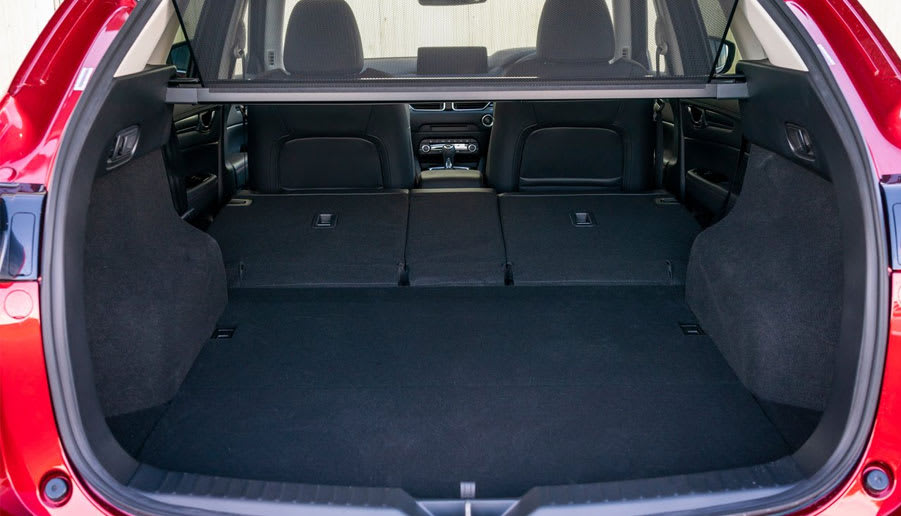
The boot is a decent size at 506-litres, increasing to 1620-litres with the rear seats folded down. This is bigger than a Ford Kuga (475 to 1534-litres) and a Kia Sportage (491 to 1480-litres) but smaller than a Toyota RAV 4 (580 to 1690-litres), with the Peugeot 5008 (780 to 1940-litres) and the Skoda Kodiaq (720 to 2065-litres) comfortably beating it.
Nevertheless, the boot is very accessible, maximising the use of the available space. So unless you intend to move a piano, there is very little that you’ll struggle to fit into it.
Underneath the boot floor, you’ll find a tyre repair kit, while you can fold the rear seats down automatically by pulling a handle or two.
Safety
The Mazda CX-5 was last tested by Euro NCAP back in 2017 and earned a five-star rating.
It did particularly well for adult occupants, rated at 95%, scoring 80% for child occupants, but only 59% for safety assists.
Nevertheless, a lot has been added to the CX-5 since then. So, there is every reason to be confident that the car is, in practice, even safer today.
Autonomous Emergency Braking is offered as standard across the range, which automatically brakes if something obstructs the road while you’re on the move. A similar system means you’ll even get this while reversing on the GT Sport trim.
Lane-keep assist, and blind-spot monitoring are also included on all CX-5s, along with adaptive cruise control to keep you a regulated distance from the vehicle ahead.
Options
The options list for the Mazda is hilariously bizarre and gets weirder and weirder the more you look into it.
Firstly, you can have aluminium pedals. That's fine. Except you can opt for each one separately. So, if you have a manual, you could decide only to have the aluminium accelerator and clutch pedal, but leave the brake pedal as it is. So why on earth would Mazda sell them individually?
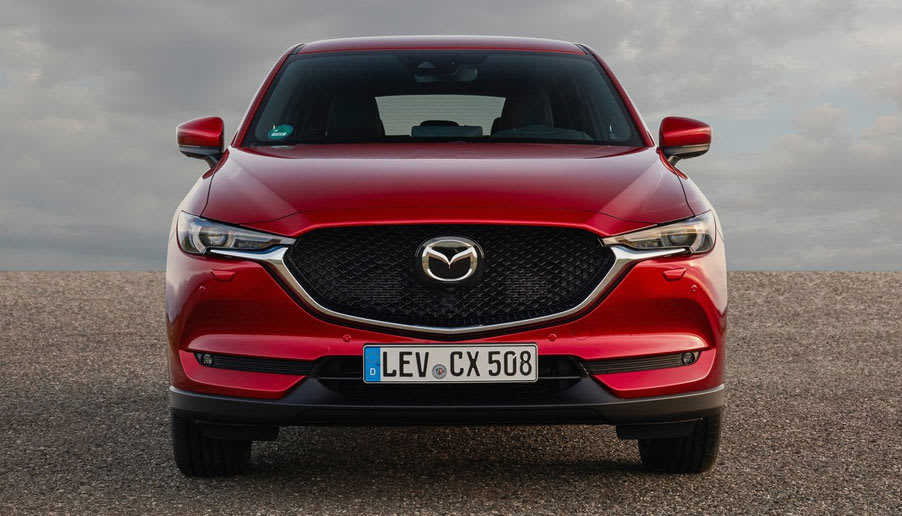
Secondly, the styling. If you go for the Sport or GT Sport trims, naturally, you’ll get sports styling on the car, right? Nope. The additional bits of decoration, such as the front, side and rear skirts or different coloured mirrors – you know - the stuff that makes the car look sporty? They are all optional extras, too.
What’s even more bizarre is that the sports styling is available on every model, so you could add it to the entry-level CX-5 if you wanted to, which would then look sportier than the two sport models.
Nope. We can’t understand it either.
And thirdly, the wheels. Nobody should have to pay for the privilege of not having their alloys nicked. Yes, locking wheel nuts are an added extra, too.
On the plus side – as actually having a choice of wheels appears to be a rarer thing nowadays for some reason – you can pick from five designs of 17-inch alloys and a selection of three different 19-inch rims.
Again, all variants are available for all models, so if you want to improve ride comfort, you can choose to downgrade to 17-inches if your car has 19-inches as standard and, likewise, upgrade to 19-inches if you have the 17-inch wheels as standard.
Rival Cars
There are plenty of alternatives you will want to shortlist.
The VW Tiguan is one of the rivals to consider, while Peugeot’s 5008 and Seat’s Tarraco also handle very well and are well worth looking at.
The Ford Kuga, Kia Sportage, Toyota RAV4, Skoda Kodiaq and the Citroen C5 Aircross are also worth looking into.
Verdict & Next Steps
Overall, it is not surprising that the CX-5 accounts for such a high proportion of Mazda’s sales.
It is relatively good looking, spacious, practical and fun to drive for such a big car – and it gets a thumbs up from us.
But, while it handles well, it does have its drawbacks, and some of its other rivals are arguably better and can offer more.
On the plus side, the bizarre options list means you can go for the entry-level trim but then add the sports styling, meaning you can opt for a lower-spec trim without suffering that feeling of inadequacy when a top-of-the-range CX-5 GT Sport pulls up alongside you at the traffic lights.
It might well beat you off the line, but at least you’ll be the one laughing.
Unless the person in the GT Sport has seen the options list, too.
Where to next?
View latest Mazda CX-5 leasing deals - guide price from £264.25 per month inc VAT**
Looking for a great deal? Check out our incredible range of car lease deals
New CAR Read our latest Reviews and find the right model for you
Want to know more about leasing? Take a look at our comprehensive Leasing Guides
Interested in everything motoring? Why not catch up on all the latest Car Leasing News.
*Score based on Select’s unique meta score analysis, taking into account the UK’s top five leading independent car website reviews of the Mazda CX-5
**Correct as of 18/08/2021. Based on 9 months initial payment, 5,000 miles over a 48 month lease. Initial payment equivalent to 9 monthly payments or £2,378.27 - Ts and Cs apply. Credit is subject to status.



















